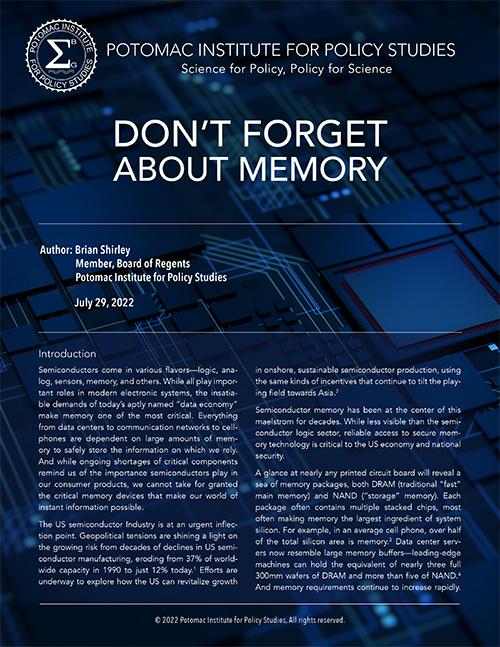Featured

Author: Brian Shirley
Member, Board of Regents
Potomac Institute for Policy Studies July 29, 2022
Semiconductors come in various flavors—logic, analog, sensors, memory, and others. While all play important roles in modern electronic systems, the insatiable demands of today’s aptly named “data economy” make memory one of the most critical. Everything from data centers to communication networks to cell- phones are dependent on large amounts of memory to safely store the information on which we rely. And while ongoing shortages of critical components remind us of the importance semiconductors play in our consumer products, we cannot take for granted the critical memory devices that make our world of instant information possible.
The US semiconductor Industry is at an urgent inflection point. Geopolitical tensions are shining a light on the growing risk from decades of declines in US semi- conductor manufacturing, eroding from 37% of world- wide capacity in 1990 to just 12% today. Efforts are underway to explore how the US can revitalize growth in onshore, sustainable semiconductor production, using the same kinds of incentives that continue to tilt the playing field towards Asia.
Semiconductor memory has been at the center of this maelstrom for decades. While less visible than the semi- conductor logic sector, reliable access to secure memory technology is critical to the US economy and national security.
A glance at nearly any printed circuit board will reveal a sea of memory packages, both DRAM (traditional “fast” main memory) and NAND (“storage” memory). Each package often contains multiple stacked chips, most often making memory the largest ingredient of system silicon. For example, in an average cell phone, over half of the total silicon area is memory. Data center servers now resemble large memory buffers—leading-edge machines can hold the equivalent of nearly three full 300mm wafers of DRAM and more than five of NAND. And memory requirements continue to increase rapidly.
See Full Report here.
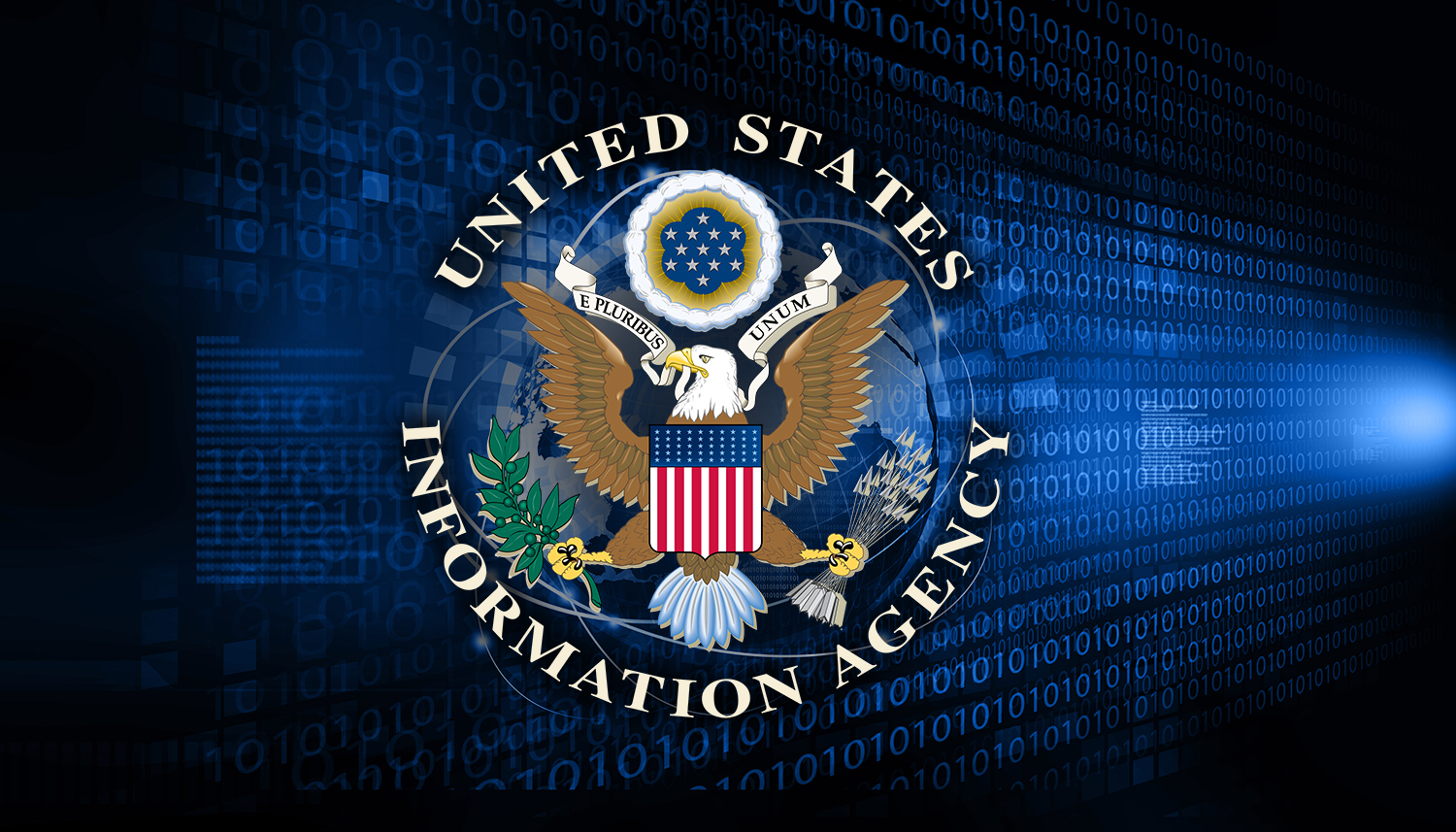
Reclaiming the Narrative: The US and International Communications
May 4, 2022 | Potomac Institute for Policy Studies
Authors: Curtis Pearson, Vice President, Potomac Institute for Policy Studies
Jody Moxham, Senior Fellow, Potomac Institute for Policy Studies
Jeffrey “Skunk” Baxter, Senior Fellow and Member, Board of Regents, Potomac Institute for Policy Studies
The Shining City upon a Hill
Not long ago, the United States was universally perceived as that shining “city upon a hill”—a modern nation founded solely on an idea and serving as a beacon of freedom for the whole world. For 40 years, an independent, federally-funded organization had promoted the core values of the United States, broadcasted local and international news, and shared free and open information with the rest of the world. Today, that organization, the US Information Agency (USIA), has largely ceased to exist and the world has lost a trusted, independent voice.
There Once was an Agency
 The revolution in communications that connects peo- ple and nations online has placed the United States in a global competition of ideas ideas and memes. The US is ill-prepared to compete successfully in this realm. We are losing because we are not communicating a clear, coherent narrative of our intentions and actions in ways understood and trusted by the world. We have no coordinated plan for communicating that narrative and no national strategy for communications.
The revolution in communications that connects peo- ple and nations online has placed the United States in a global competition of ideas ideas and memes. The US is ill-prepared to compete successfully in this realm. We are losing because we are not communicating a clear, coherent narrative of our intentions and actions in ways understood and trusted by the world. We have no coordinated plan for communicating that narrative and no national strategy for communications.
Americans aspire to certain values articulated in the founding documents that provide the core constructs of the United States, namely: justice, freedom, peace, and the duty to protect those values. But today, our nation is no longer actively sharing the strong belief in those values with the rest of the world. The United States government, in particular, is no longer seen as a reliable source of truth. In 1999, the US State Department absorbed frac- tured parts of the USIA. It didn’t take long for decision makers to realize that relinquishing an independent voice was a bad idea. Two years after the State Department took over the USIA, then-Secretary of State Madeline Albright, who had overseen the plan, expressed concern that folding USIA into the State Department might have been a mistake. By 2001, the nation felt the loss of an independent and trusted voice telling our story.
The USIA’s charter separated it from political bodies and provided governance that insured its independence, free from political influence. This independence, whether perceived or real, was lost when factions of USIA were absorbed into the US Department of State. Since then, the Broadcasting Board of Governors and other organizations have attempted to foster an independent voice on behalf of the United States. They have not maintained the level of trust previously held by USIA. The USIA was held in high regard and was generally believed to speak the truth con- cerning the United States—whether good, bad, or ugly.
Given this absence of authentic voice, we believe that our nation, and indeed the world, again needs to reconstitute an independent resource that can coordinate our messaging and relationships on the world stage, and in so doing, can earn back and maintain trust as a source of truth.
This new resource might be a new agency, like the USIA, or an independent function of an existing orga- nization with authority and accountability to coordi- nate various agencies with tasking in public diplomacy and strategic messaging.

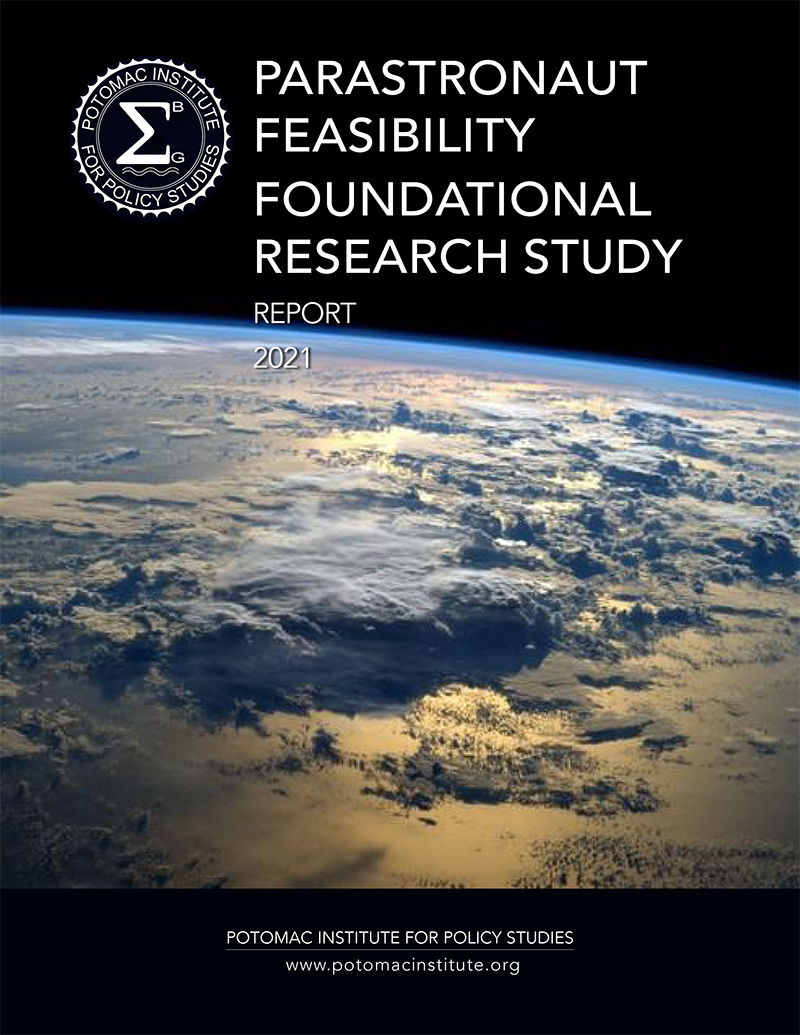 The Potomac Institute for Policy Studies is releasing the findings of a months-long study for the National Aeronautics and Space Administration’s (NASA) Office of the Chief Health Medical Officer entitled: “Parastronaut Feasibility Foundational Research Study”. NASA engaged the Institute to identify what it would take to fly astronauts with disabilities safely into space and back to Earth.
The Potomac Institute for Policy Studies is releasing the findings of a months-long study for the National Aeronautics and Space Administration’s (NASA) Office of the Chief Health Medical Officer entitled: “Parastronaut Feasibility Foundational Research Study”. NASA engaged the Institute to identify what it would take to fly astronauts with disabilities safely into space and back to Earth.
For years, NASA has selected astronauts based on certain physical parameters including having full, unobstructed use of limbs with little, if any, consideration to candidates who may not meet these criteria. This study looks specifically at astronauts with certain physical disabilities including individuals with lower leg deficiency, short stature, and/or leg length differences, among others. The Institute consulted with medical experts, military leaders, industry leaders, other organizations and stakeholders, and subject matter experts including former astronauts Former NASA Administrator Major General Charles Bolden and Former NOAA Administrator Dr. Kathy Sullivan. With their guidance, this report outlines policy recommendations, technical, medical, and operational hurdles, and considerations to make sure potential parastronauts can safely fly and contribute to space missions.
CEO of Potomac Institute Dr. Jennifer Buss stated, “There are ways to safely send parastronauts into space. It is vital NASA and space agencies around the world look to include a wider range of space flight candidates, and not exclude any potential exemplar astronaut candidates based on physical limitations that do not align with current technological and medical advances. Our findings and recommendations stem from months of data collected from interviews, research, and other methodologies.”
The Institute has two versions of the report to release. You can read an abbreviated version of the report here and the full version of the report is available here which will link to the Institute’s website. For interview requests with Institute staff or our subject matter experts, please contact Communications Director John Mecham at This email address is being protected from spambots. You need JavaScript enabled to view it..
Click here to see the article on space.com
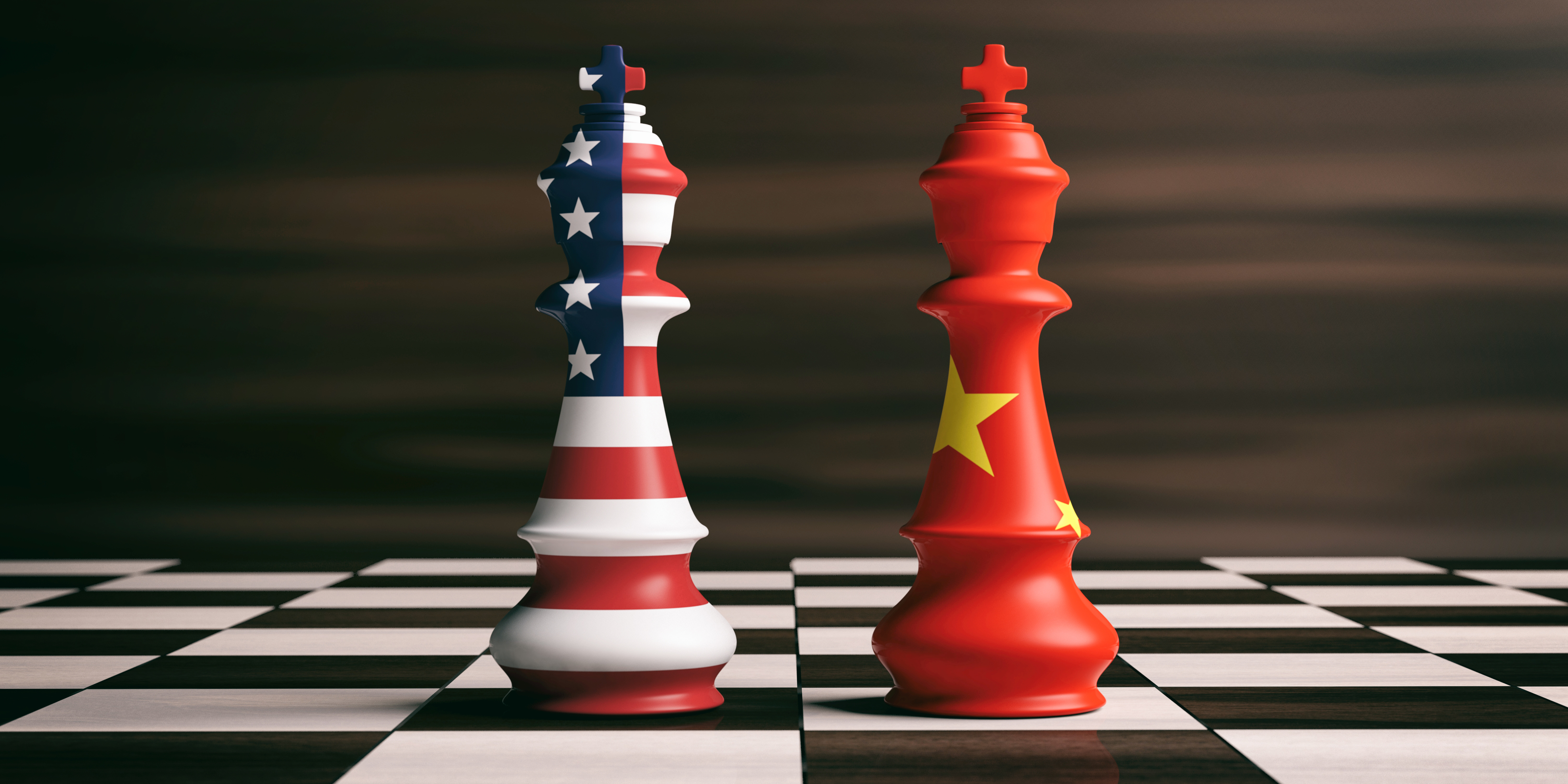
US National Security in a New Era of Intense Global Competition

The Honorable Zachary J. Lemnios, Member Board of Regents, Potomac Institute for Policy Studies
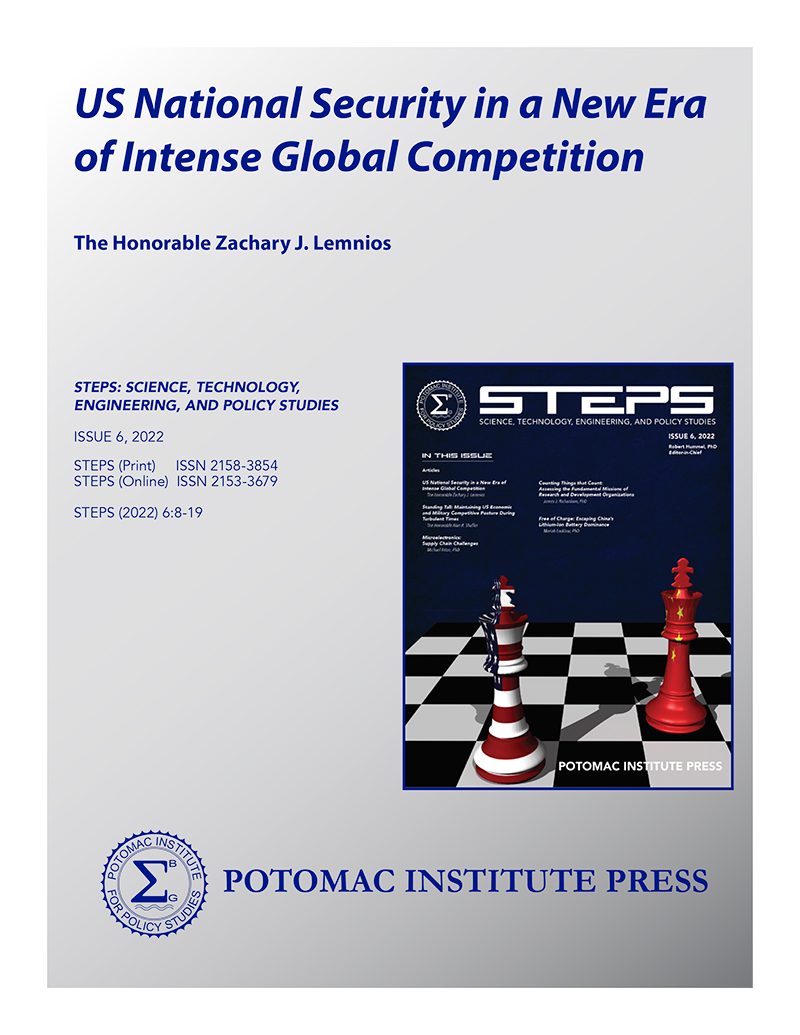 A New Era
A New Era
The United States and China are in a great power competition that will have profound impact on the national security and economic security of both countries for decades.1,2 This competition aligns across interdependent economic, military, and political vectors. At the core, this is a competition of ideals and governance. But unlike the 20th century Cold War competition with the Soviet Union, the competition with China involves new challenges. The resulting tension between the US and China has opened a new era requiring a new national security framework.3,4
In the past, the United States has confronted the need for a complete transformation in the national security environ- ment. For example, after World War II and the proliferation of nuclear weapons capabilities, the nation undertook Project Solarium and the Project Charles Air Defense Study to define a new national security operating model to con- tain the Soviet Union.5 The competition with China poses an equally significant challenge now.

Economic Competition
The United States and China are in a fierce rivalry span- ning a broad range of global markets and complex global supply chains. In 2020, US goods imports of $435 billion and exports of $125 billion reflect a trade imbalance with China. Persistent trade imbalances of this magnitude are unsustainable. This is caused by a complex competition in which the playing field is skewed and can lead to global market instability. Our companies and supply chains are interrelated. We depend upon each other’s markets and host each other’s companies.
The “Made in China 2025” plan, published in 2015, is China’s ten-year plan to reduce China’s dependence on foreign technology and to promote China’s technology position in the global marketplace.6 China is focused on leading ten key high-tech industries (see the “Made in China 2025” figure above). Particular technology areas of competition with the US include information technology, robotics, new materials, and aerospace equipment. This plan is structured to raise the Chinese domestic content of core components and materials to 70% by 2025. The plan is the foundation of China’s economic competition.
The initial salvo for strategic industry leadership began with 5G wireless-telecommunications, as part of the “new information technology” sector. This is the entry point to the global digital and cyber-physical infrastructure with the opportunity to control the network infrastructure. This is also the path to position China as a “first mover” in training artificial intelligence (AI) algorithms on massive global data, driving AI to the network edge and accelerating digital transformation across many industries.7
As a result, China is driving the development of technologies in the 5G telecommunications sector, led by its pri- vate sector companies Baidu, Alibaba, Tencent, Huawei, and ZTE (Zhongxing Telecommunications Company Ltd.). While there are over 200 Chinese companies listed on US stock exchanges with a total market capitalization in excess of $2.2 trillion, Huawei and ZTE have been the subject of special scrutiny.8 In late 2019, the Wall Street Journal reported that Huawei had access to as much as $75 billion in support from the China state government.9 In July 2020, the US government officially designated Huawei and ZTE as threats to US national security, because of their close ties to the Chinese Communist Party and China’s military apparatus and their legal obligation to cooperate with China’s intelligence services. More recently, White House Executive Order 13959 identified 59 Chinese entities for which US investments are banned by the Treasury Department.10
The “new information technology” sector of the “Made in China 2025” plan also depends on advanced semiconductor technology. State-of-the-art-microelectronics requires a complex supply chain with specialized technical talent and massive capital investments. Manufacturing facilities (fabs) are benchmarked by semiconductor wafer size (measured in millimeter in diameter), manufacturing volume (wafers/ month) and smallest printed geometric feature (nanometers). Today’s state-of-the-art products are manufactured on 300mm wafers at 5nm geometries. At the end of 2018 there were 112 production-class fabs globally utilizing 300mm wafers.11 The global industry is projected to add at least 38 new 300mm fabs by 2024. Of these, Taiwan is expected to add 11 large-volume fabs, and China will add 8 to account for half of the global 300mm large-volume fabs by 2024. To support this, the China state government has established an investment fund of $150 billion to finance mergers and acquisitions for companies and technologies in the semiconductor industry.12
As a result, China is poised to successfully compete in the semiconductor sector. China is making significant investments and now has 13% of the global fabless market, up from 5% in 2010.13 The Chinese semiconductor manufacturing sector has seen an average compound growth rate of nearly 25% since 2014.14 Design of semiconductors is also making significant progress in China. In 2019, China’s semiconductor design sector reached a level that surpassed Taiwan, making China the second-largest design industry cluster after the United States globally. China’s share of semiconductor design grew from 3.6% in 2004 to nearly 43% in 2019.15 Leadership in semiconductor design and manufacturing implies leadership in new information technology, which is but one sector of emphasis of the “Made in China 2025” plan for economic competition.
The US has begun to recognize the criticality of America’s supply chains and the economic security and national security challenge posed by foreign disruption. The recent White House review on this topic launched a comprehensive whole-of-government effort to strengthen domestic competitiveness and supply chain resilience across four critical sectors: (1) semiconductor manufacturing and advanced packaging, (2) large capacity batteries, (3) critical minerals and materials, and (4) pharmaceuticals and active pharmaceutical ingredients.16
To answer the challenge of economic competition, the US will need to greatly improve its ability to understand the national security implications of foreign economic developments and to provide better security for its own developments. New technologies can assist in addressing the national security implications of economic competition. Pursuit and integration of these directions into a comprehensive national defense apparatus might require new agencies and resources. Technology concepts, adapted from the commercial sector, could open new approaches to respond to economic challenges. These include the following.
- Development and utilization of real-time national financial models to provide early warning indicators of critical supply chain disruptions, on both sides, thereby playing long-term offense and defense. Statistical models applied to open-source financial and industry data are being used today by companies to optimize global supply chain efficiencies and costs. With additional data, these could be used at a national level to preemptively forecast supply chain risks and economic impact and to make decisions to secure critical supplies for national needs.
- Development and utilization of macroeconomic models to forecast foreign government involvements across global markets, and to provide early indicators of potential disruptive activities. For example, modeling mainland China’s potential economic futures with Taiwan would help to better understand and shape the region to thwart conflicts. Monte Carlo simulation techniques exist today to model thousands of scenarios and alert on early warnings and emerging scenarios, and to game threats and optimize responses. Analysts today monitor military threats; future analysts will use tools to analyze economic threats.
- Utilization of blockchain, watermarking, design partitioning, and hardware obfuscation security approaches. Such approaches, emerging for use in commercial venues, can mitigate risks of counterfeiting, intellectual property theft, and tampering. A national approach is needed to integrate in-line data from millions of sen- sors across complex global supply chains with comprehensive analysis of the data to model and deploy strategies to defend the economic homeland.
Military Competition
Military strength and resiliency comprise a second element of competition. China’s strategy of “Military-Civil Fusion” poses significant challenges for the US and our allies. China’s Military-Civil Fusion development strategy has leveraged a whole-of-government approach to achieving parity with the United States in several military areas, including air defense systems, land-based conventional ballistic and cruise missiles, and shipbuilding.17 The prospect of China developing and fielding advanced military capabilities by integrating research across its commercial sector with its military and defense industrial sectors, is a key element of this great power competition.
The Communist Party of China (CPC) Central Committee has established the goal of building a “fully modern military” by 2027, with the capability to defend national sovereignty, safeguard against security threats in the western pacific region, and protect overseas development interests as China’s global economic presence grows.18 These plans include accelerating its integrated development in “mechanization,” “informatization,” and “intelligentization,” comprehensively strengthening military training and preparation. A recent report outlines the pace and impact of China’s military modernization, with a focus on the People’s Liberation Army’s (PLA’s) strategy to use science and technology for military purposes.19
Over the past decade, China has made significant progress in key technical areas including radio frequency systems, electronic warfare, hypersonics, and more recently quantum computing. As an example, Chinese researchers recently published an approach to network hypersonic weapons into a smart swarm for coordinated attacks.20 The concept opens the alarming prospect of a saturation attack that would be difficult to counter, even with future air defense systems. Particularly alarming are the references that the Beijing Institute of Technology authors cited, including the Raytheon Tomahawk Cruise Missile (RGM/UGM-109) Technical Manual and System Description.
In the field of quantum technologies, the Intelligent Perception Technology Laboratory of the 14th Institute of China Electronics Technology Group Corporation (CETC) announced China’s first quantum radar system in 2016 and displayed a mockup at the Zhuhai Airshow in 2018.21,22 More recently, China opened the world’s largest quantum research center to push the frontier of quantum computing. The National Laboratory for Quantum Information Sciences, a $10 billion four-million square foot facility, has programs in quantum sensing, self-contained navigation, quantum computing, and quantum communications.
The United States has relied upon US technology leadership, unmatched engineering talent, and highly trained military personnel to build, deploy, and operate the world’s most technologically advanced military. With the development and availability of key advanced technologies from the commercial sector, nation state competitors and non-state actors now have equivalent access, eroding the technology overmatch to which our nation has grown accustomed. To recover and maintain technology superiority for military systems, new emphasis needs to be placed on defense technologies, involving new researchand development agencies and approaches. Some concepts that should be explored prior to establishing such centers include the following.
- Faster movement toward reinvigorating US technology development demonstrating and fielding advanced technology in key areas . The Department of Defense can do so by expanding its Federally Funded Research and Development Centers (FFRDCs) and Department Laboratories, or instituting new ones, in partnership with US industry. By using new partnership models to engage in a campaign of continuous development with field testing and integration, the US can match and exceed the efficiency of China’s Military-Civil Fusion model for military systems development.
- Tools and techniques for persistent Gray Zone operations in competition with China. New approaches are needed to comprehend the long-term regional environment—economically, politically, and militarily. Long-duration campaign planning tools must employ tailorable and reversible effects at the most effective points in a regional campaign. Machine learning and dynamic planning could be adapted from the commercial sector and tailored with appropriate sensor data and modeling to preemptively plan for emerging scenarios. Emerging tools and techniques are beginning to provide military planners a “look ahead” into incipient scenarios and the opportunity to plan accordingly.23
- A new deterrence strategy to address a combined Nuclear, Chemical, Biological, Cyber (NCBC) threat, expanding the range of highest priority threats requiring national capabilities . New deterrence, detection, and countermeasure techniques are needed considering that any combination of NCBC employment could present an existential threat to the United States. Natural or man-made, the COVID-19 pandemic resulted in millions of deaths and crippled the world’s economy for many months. Fielding a global NCBC early warning capability is essential as engineered pathogens could have a similar impact. Deploying such a capability globally with allies and partner nations requires US global leadership.
Political Competition
Political strength is the third, and perhaps most challenging, element of the great power competition between the United States and China. China has harnessed its political and military strength in the South China Sea on a Gray Zone strategy. This has become an operati-onal domain characterized by a long campaign of low threshold actions to achieve long-term strategic objectives without crossing the threshold of military confrontation.24 It includes elements of Hybrid Warfare25 and Soft Power.26
China and Russia are increasingly using Gray Zone means to achieve their objectives without direct military engagement and below the level of war.27 The Gray Zone is growing rapidly in the South China Sea, where China is using coercion, intimidation, propaganda, and manipulation to expand its position in the region.28 China has built an artificial island chain, reclaimed disputed land, militarized islands, and is using legal arguments and diplomatic influence to expand its position.
In early 2020, China’s State Council established two new districts in Sansha City, a prefecture-level city headquartered on Woody Island which governs the bulk of China’s territorial claims in the South China Sea. This development will expand China’s control over the region and further complicate political and diplomatic dynamics.
While military deterrence is essential, the United States and our allies need a set of new technical and operational capabilities to operate in a persistent and multidomain Gray Zone.29,30
Prevailing in a prolonged political competition with China requires the United States to develop and implement a whole-of-government approach to integrate economic, political, and military signatures, indications, and warnings. The following technical approaches should be explored and deployed.
- Intelligence, advanced forecasting, and decision support capabilities to detect, tailor, and preemptively plan economic, political, and military actions. Political actions can involve influence operations, marketing, competitive assistance, as well as tariffs and sanctions. Techniques can be adapted from the commercial sector to process live-stream data and alert on emergent behavior.
- Whole-of-government synchronous strategic messaging and information operations using approaches from the commercial sector. Social media has opened a new strategic communication channel for enabling red teaming against a range of simulated actions and responses from China. The development of multi-domain models could open the prospects of predictive risk assessment to extend our economic, political, and military options.
- New technical approaches to detect and protect government, enterprise, and private information that are increasingly entangled and increasingly vulnerable. Developing an effective layered information defense system is a daunting challenge. In addition to protecting critical infrastructure, effective capabilities would position the United States as a leader in information security, countering China’s cybersecurity laws that permit the government to obtain any information that they deem has an impact on Chinese security.

Peer-level Challenges of the Past
The US has faced peer-level national challenges in the past. Our peer-level competition with China on the economic, military, and political levels is no less daunting than the confrontation with the Soviet Union some 70 years ago.
The Soviet Union detonated its first atomic bomb in September 1949, and by 1951, the Korean War had begun as a proxy war with the Soviet Union. With growing geopolitical tension between the United States and the Soviet Union, the US confronted the possibility of a devastating surprise attack.
In response, the US completely revamped the defense system in the 1950s and beyond. A strategy of containing the Soviet Union was devised, and more importantly, enacted. For example, the Project Charles Air Defense Study, begun in 1951, was more than a study, but a four-month effort to design short- and long-term development of an early warning system for attacks that might emanate from the Soviet Union.31 It led to the formation of MIT Lincoln Laboratory,32 and engaged scientists and engineers from across industry and academia, and military liaisons, to outline many of the principles of today’s air defense systems. They focused on early warning target detection and discrimination, threat interception, and command and control. Project Charles working groups were briefed on Soviet strategic capabili- ties and visited military operational field sites. They evaluated approaches to detect a small number of threat aircraft buried in a large constellation of commercial aircraft, and
the importance of field testing a prototype system comprised of a network of small radars connected to a central computer at a command center.
With urgency to quickly counter the Soviet threat, the Project Charles Study outlined a development program that included short-term extensions of current technologies and longer-term plans to leverage an “electronic high-speed digital computer...and the revolution that the transistor will bring about in electronics to open up quite new possibilities in aircraft and weapon control.”33 These options were available because the United States led the world in radar, electronic warfare, communications, electronics, display, and other key technologies needed to deploy an initial early warning system.34
Resulting contracts and development, called “Project Lincoln,” led to the Semi-Automatic Ground Environment (SAGE) system and the Distant Early Warning system. Rand Corporation, another Federal Contract Research Center, was involved in developing the programming for the sophisticated mainframe computer, and MITRE was founded in 1958 to operate and expand the system.35 SAGE protected the United States into the 1980s.36,37
The use of federally funded research and development centers (FFRDCs) was established for challenges that cannot be met solely through the commercial sector. As national security threats evolved from bombers to intercontinental ballistic missiles, FFRDCs focused their efforts on a major initiative in ballistic missile defense. This began in the late 1950s, expanded in the 1960s and grew significantly in the 1980s with President Reagan’s establishment of the Strategic Defense Initiative.38 This work was critical to US national security and led to software and hardware concepts which are in use today, including collection and analysis of test data, high fidelity simulations, critical discrimination techniques, and design of new radar and infrared sensors.
Lessons Learned from the Cold War Competition
We can learn from the competition between the United States and the Soviet Union in the second half of the 20th century. The Cold War was a competition between liberal democracies and communism, just as we now confront a competition with a different form of government. The Soviet Union’s self-proclaimed world power centered on its massive number of ballistic missiles with nuclear munitions. Without its ballistic missiles, the Soviet Union could not project power very far beyond its regional boundaries.
In our current confrontation, the protagonists are, as before, very careful not to engage with each other in direct military confrontation. Just as the Cold War lasted about 40 years, the current competition is likely to last for multiple decades. The United States, with superior technology, won the Cold War. The US competed with the Soviet Union in a technology race to directly challenge their missile force with developments such as the Strategic Defense Initiative. The Soviet Union was in no position to engage and thus, conceded defeat when President Yeltsin dissolved the Soviet Union on December 8, 1991.39
Interdependent Elements of this Great Power Competition
While military, economic, and political interdependencies are not new, we are now in competition with a peer nation where military strength alone is not sufficient to succeed.
In a similar manner, new technical capabilities and operational concepts are needed to prevail in a long-term great power competition with China, which may also last for decades. In each element of great power competition, there are possible solutions, involving technology, policies, and investments in research and development.
But in developing solutions, we must recognize the interdependencies and interoperability of these capabilities. Responses in one area will affect other areas, and to prevail, we must respond in all areas. Each of these domains—economic, military and political—have unique signatures and can be competitively modeled. But it is the interplay between domains that is critical. The challenge is to decompose this into a cross-domain model, fed by live-stream data to provide insight for preemptive courses of action. This is a messy, loosely structured, data-rich environment with a host of potential threats and ambiguities. It is also the environment we must understand and in which we must prevail.
A Call to Action
The United States and China are in a protracted great power competition that will have profound impact on the national security and economic security of both countries for decades. The complex and interdependent economic, military, and diplomatic tension between the US and China has opened a new era of national security challenges. Just as superior technology allowed the United States to prevail against the Soviet Union, technology solutions will be the deciding factor in our current competition.
And yet, our current structures for acquiring and applying technologies are inadequate for the challenges posed by the new great power competition. The Defense Industrial Base designs and builds weapon systems with advanced technology. The commercial sector is remarkably effective at developing high technology commercial goods. Private industry, often with government help, invests in technologies for health care, transportation, energy, space, materials, and manufacturing. Basic research capabilities and advance- ments are strong. What is lacking, however, is an integrated approach to addressing the interlocking economic, military, and political competition with those who have developed their own capabilities and technological progress.
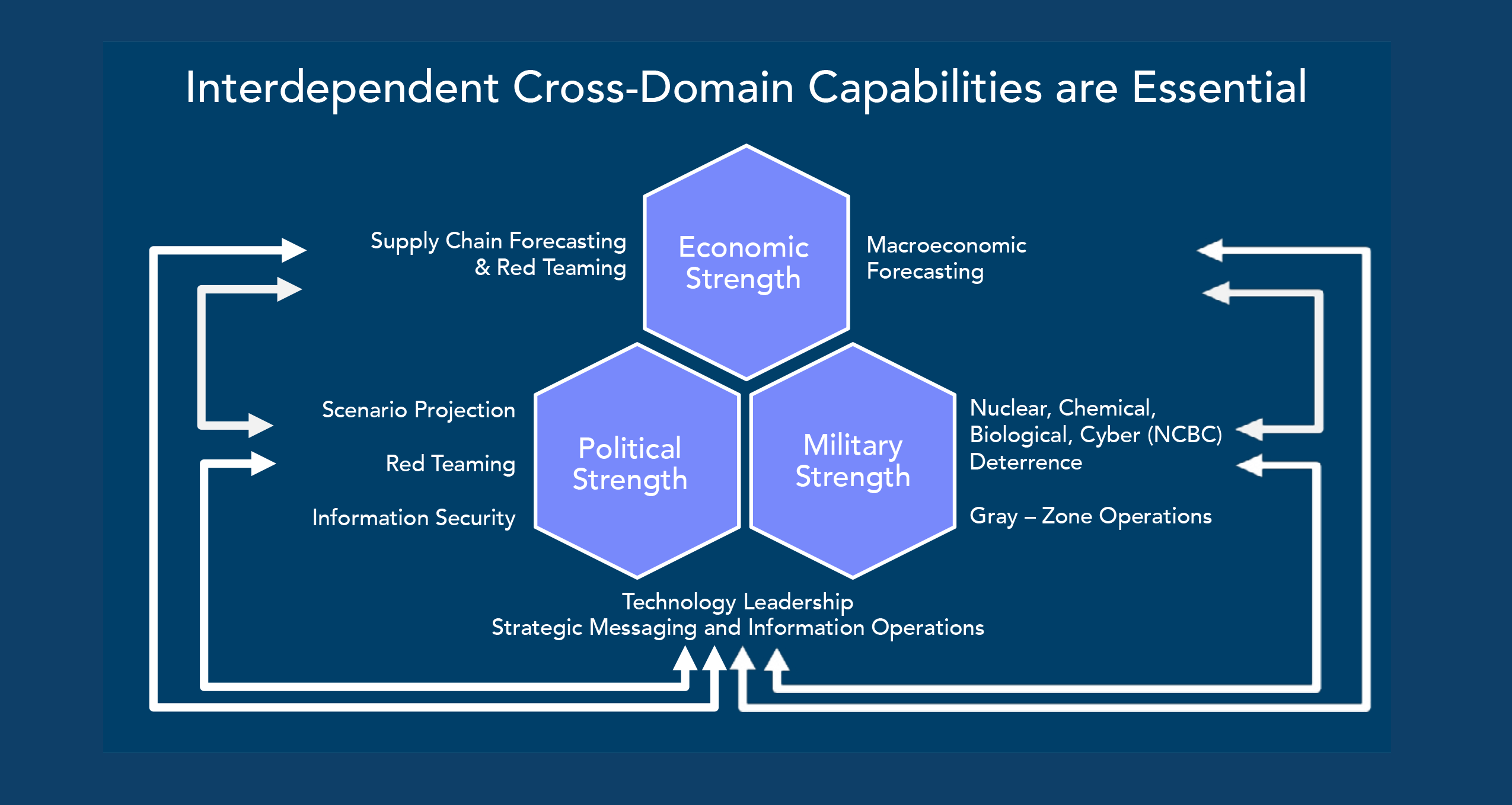
A focused executive commission is urgently needed to frame this multi-domain challenge, to include talent from across industry, academia, government, and the military. Like Project Solarium and Project Charles, the study needs to involve the most senior, trusted, and intellectual experts in the nation. The study’s “Terms of Reference” should be succinct and blunt: How can the United Stated prevail in the great power competition with China? What new capabilities do we need? What are the operational models and how are these integrated across whole-of-government? Bold ideas merit exploration.
This will not be a study typically conducted by agencies today. This commission needs to have an impact. Both short-term and long-term recommendations must lead to action, both executive and legislative.
The results are certain to support a restructuring of our technology development enterprise. Near-term fixes will be proposed to leverage novel technologies. But long-term developments will also be needed. New long-term institutions are likely to be proposed, including new FFRDCs and new government laboratories. These might be carved from existing institutions, but they also might require new centers to support evolving needs. A pipeline of human capital and infrastructure resources will be necessary. Support to the military’s combatant command at United States Indo-Pacific Command (USINDIOPACOM) will be critical to develop and validate cohesive econometric/military/political models that can be integrated through operations. Other combatant commands and collaboration with allies will be equally important. New weapon systems for deterrence will be but one aspect of fortifying a great power competition in the economic, military, and political domains.
The United States has risen to grand challenges in the past, but only by taking bold and decisive steps. Those actions served to prevail in the past, but only after commitments that lasted decades. Today’s challenges require similar kinds of commitments. It is time to frame the problem, propose approaches, and make those commitments.
Notes:
1. Anthony H. Cordesman, Chinese Strategy and Military Forces in 2021, Center for Strategic International Studies June 7, 2021, https://csis-website-prod.s3.amazonaws.com/s3fs-public/publication/210607_Cordesman_Chinese_Strategy.pdf?fG7hUZdWUVJgaJzyC4E9Qj1m3w13SfjQ
2. National Defense University Press, PRISM 8 (4) June 2020, https://ndupress.ndu.edu/Portals/68/Documents/prism/prism_8-4/prism_8-4.pdf
3. The Policy Planning Staff, Office of the Secretary of State, The Elements of the China Challenge, December 2020, https://www.state.gov/wp-content/uploads/2020/11/20-02832-Elements-of-China-Challenge-508.pdf
4. F.W. Loomis, Problems of Air Defense: Final Report of Project Charles, Contract Number DA36-0039sc-5450, August 1, 1951, http://www.bitsavers.org/pdf/mit/lincolnLaboratory/project_charles/A800165_Final_Report_of_Project_Charles_Vol_1_Aug1951.pdf
5. Department of State Office of the Historian, Foreign Relations of the United States, 1952-1954, National Security Affairs, Volume II, Part 1, “Paper Prepared by the Directing Panel of Project Solarium,” https://history.state.gov/historicaldocuments/frus1952-54v02p1/d69
6. The People’s Republic of China State Council, Made in China 2025 Plan May 19, 2015, http://english.www.gov.cn/policies/latest_releases/2015/05/19/content_281475110703534.htm
7. State Council Notice on the Issuance of the New Generation Artificial Intelligence Development Plan, A New Generation Artificial Intelligence Development Plan, July 20, 2017, https://www.newamerica.org/cybersecurity-initiative/digichina/blog/full-translation-chinas-new-generation-artificial-intelligence-development-plan-2017
8. U.S.-China Economic and Security Review Commission, Chinese Companies Listed on Major U.S. Stock Exchanges, https://www.uscc.gov/research/chinese-companies-listed-major-us-stock-exchanges
9. Chuin-Wei Yap, “State Support Helped Fuel Huawei’s Global Rise,” Wall Street Journal, December 25, 2019
10. US Department of the Treasury, Issuance of Executive Order Addressing the Threat from Securities Investments that Finance Certain Companies of the People’s Republic of China & Related FAQs; Introduction of Non-SDN Chinese Military-Industrial Complex Companies List, https://home.treasury.gov/policy-is-sues/financial-sanctions/recent-actions/20210603
11. Semi, 300mm Fab Spending to Boom through 2023 with Two Record Highs, November 3, 2020, https://www.semi.org/en/news-media-press/semi-press-releases/300mm-fab-outlook
12. U.S. Chamber of Commerce, Made in China 2025: Global Ambitions Built on Local Projections, 2017, https://www.uschamber.com/assets/archived/images/final_made_in_china_2025_report_full.pdf
13. Antonio Varas, Raj Varadatajan, “How Restrictions to Trade with China Could End US Leadership in Semiconductors”, Boston Consulting Group, March 2020, https://www.bcg.com/en-us/publications/2020/restricting-trade-with-china-could-end-united-states-semiconductor-leadership
14. Paul Triolo, “The Future of China’s Semiconductor Industry, American Affairs Spring 2021 5 (1), https://americanaffairsjournal.org/2021/02/the-future-of-chinas-semiconductor-industry
15. US Department of the Treasury, Issuance of Executive Order Addressing the Threat from Securities Investments, https://home.treasury.gov/policy-issues/financial-sanctions/recent-actions/20210603
16. The White House, 100-Day Reviews under Executive Order 14017. June 2021, https://www.whitehouse.gov/wp-content/uploads/2021/06/100-day-supply-chain-review-report.pdf
17. Office of the Secretary of Defense, Military and Security Developments involving the People’s Republic of China 2020, Annual Report to Congress, August 21, 2020, https://media.defense.gov/2020/Sep/01/2002488689/-1/-1/1/2020-DOD-CHINA-MILITARY-POWER-REPORT-FINAL.PDF
18. Communiqué of the Fifth Plenary Session of the 19th CPC Central Committee, October 30, 2020, http://english.www.gov.cn/news/topnews/202010/30/content_WS5f9b6f64c6d0f7257693ea0a.html
19. The National Institute for Defense Studies, NIDS China Security Report 2021: China’s Military Strategy in the New Era, Nov 2020, http://www.nids.mod.go.jp/publication/chinareport/pdf/china_report_EN_web_2021_A01.pdf
20. Shixun Luo, Zhongshan Zhang, Shuai Wang, et al., “Network for Hypersonic UCAV Swarms” Science China Information Sciences 63, Article Number 140311 (2020), https://doi.org/10.1007/s11432-019-2765-7
21. CETC 14th Research Institute, https://www.globalsecurity.org/military/world/china/cetc-14.htm
22. “China Shows off First Quantum Radar Prototype,” Aviation Week Network November 5, 2018, https://aviationweek.com/defense-space/china-shows-first-quantum-radar-prototype
23. Chris Nott, Stephen Gordon, and Leendert van Bochoven, IBM Defense Simulation Analytical Service, December 10, 2021, https://www.ibm.com/blogs/think/uk-en/defense-simulation-analytical-service/
24. George Popp, Sarah Canna, The Characterization and Conditions of the Gray Zone, NSI. Inc, Winter 2016
25. Frank Hoffman, Examining Complex Forms of Conflict: Gray Zone and Hybrid Challenges National Defense University PRISM 7(4) November 2018
26. Joseph Nye, “Soft Power” Foreign Policy No. 80, Twentieth Anniversary (Autumn, 1990), pp. 153-171
27. Lyle J. Morris, Michael J. Mazarr, Jeffrey W. Hornung, et al., Gaining Competitive Advantage in the Gray Zone: Response Options for Coercive Aggression Below the Threshold of Major War. Santa Monica, CA: RAND Corporation, 2019, https://www.rand.org/pubs/research_reports/RR2942.html
28. Oriana Skylar Mastro, Military Confrontation in the South China Sea, Council on Foreign Relations, May 21, 2020, https://www.cfr.org/report/military-confrontation-south-china-sea
29. Defense Science Board, Summer Study on Capabilities for Constrained Military Operations, December 28, 2016, https://dsb.cto.mil/reports/2010s/DSBSS16_CMO.pdf
30. Defense Science Board, Task Force on 21st Century Multi-Domain Effects, September 2020, https://dsb.cto.mil/reports/2020s/FINALMDEExecutiveSummary.pdf
31. F.W. Loomis, Problems of Air Defense: Final Report of Project Charles, Contract Number DA36-0039sc-5450, August 1, 1951, http://www.bitsavers.org/pdf/mit/lincolnLaboratory/project_charles/A800165_Final_Report_of_Project_Charles_Vol_1_Aug1951.pdf
32. lan A. Grometstein, MIT Lincoln Laboratory: Technology in Support of National Security (MA: Lincoln Laboratory MIT) 2011, http://www.ll.mit.edu/sites/default/files/other/doc/2018-04/MIT_Lincoln_Laboratory_history_book.pdf
33. SAGE: The First National Air Defense Network, IBM100 Icons of Progress, https://www.ibm.com/ibm/history/ibm100/us/en/icons/sage/
34. SAGE: The First National Air Defense Network
35. SAGE: Semi-Automatic Ground Environment , https://sage.mitre.org/
36. Kenneth Shield, The Emerging Shield: The Air Force and the Evolution of Continental Air Defense, 1945–1960 (Washington, DC: Office of the Air Force History)1991 https://archive.org/details/TheEmergingShield/page/n23/mode/2up
37. G.O. Ekstedt, The DEW Line Story (Western Electric Company)https://www.beatriceco.com/bti/porticus/bell/pdf/dewline.pdf
38. President Ronald Reagan, Address to the Nation on Defense and National Security March 23, 1983,https://www.reaganlibrary.gov/archives/speech/address-nation-defense-and-national-security
39. Michael Dobbs, “Slavic Republics Declare Soviet Union Liquidated,” Washington Post Foreign Service December 9, 1991, Page A01, https://www.washingtonpost.com/archive/politics/1991/12/09/slavic-republics-declare-soviet-union-liquidated/c15d0d5d-7e03-42c6-b1a1-6eb0568a8c80/
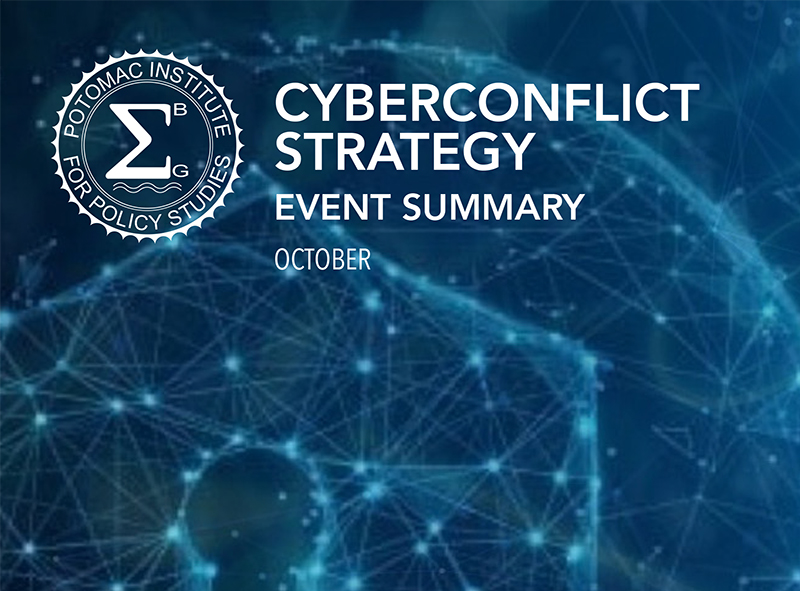
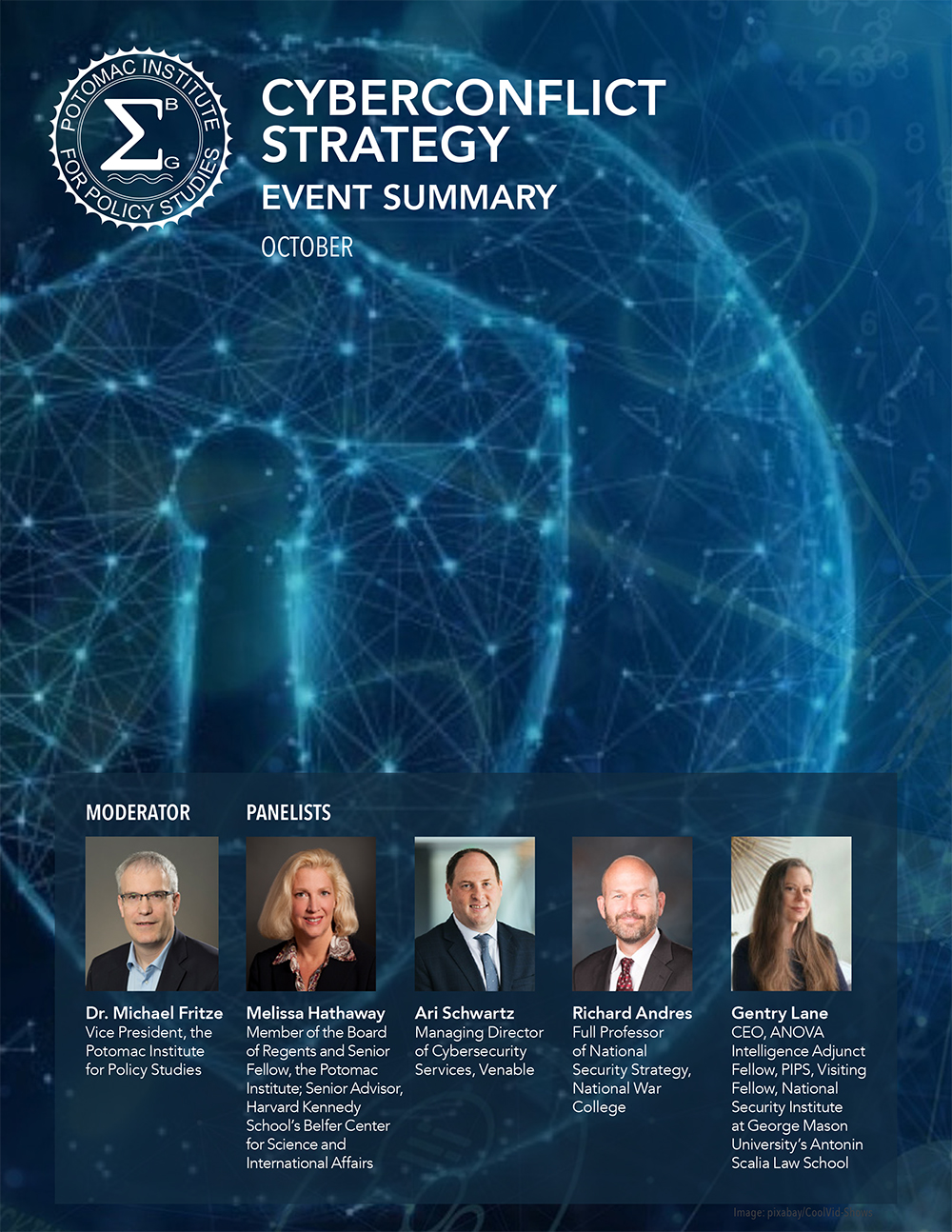 INTRODUCTION
INTRODUCTION
In the cyber domain the United States’ borders are not protected by allies or oceans, allowing adversaries unprecedented proximity to the United States’ critical infrastructure. Recent major cybersecurity events have clearly outlined the scope of the threats we face. The United States needs to prepare a whole-of-nation strategy to rebuff these threats in cyberspace. Though our adversaries are not coordinating their efforts, their combined efforts are force-multiplying each other’s work.
According to our panelists, and experts throughout the field, the United States’ critical infrastructure is extremely vulnerable to nation-state perpetuated cyber aggression.. The companies themselves, as well as the chain of businesses which support them, are being breached daily. Many private and public companies responsible for American’s most critical functions lack basic cybersecurity hygiene. Critical infrastructure are high value targets, especially during wartime. What is different now is that the U.S.’s adversaries are going after these assets during peacetime. The escalating scope, scale, and impact of ransomware since the beginning of the pandemic have grown significantly, and reporting of these attacks has increased dramatically.
Based on the recent summit between President Biden and Vladimir Putin, this is only the beginning of the beginning, not the beginning of the end of cyber negotiations. According to General Nakasone, Commander of US Cyber Command, who said this during a public Congressional hearing, Russians have compromised electrical grid. Them pulling the trigger would be catastrophic. The United States must make a whole of nation effort to prepare for this ever-growing threat surface.
The Potomac Institute’s esteemed panelists provided insights into the world of cyber criminality and warfare, considered the geopolitics of cyberspace, and offered their thoughts and recommendations as to how our nation can respond.
NATION STATES as SAFE HARBORS for CRIMINALS
Criminals are safe from extradition The idea that Russia, for example, is not perfectly aware of the cybercriminals that operate out of the country is naïve. The criminals, for their part, may be acting almost entirely out of desire for money, but the states that harbor them are getting something much more important: they are gaining an infrastructure of capable, skilled, and often trained individuals that can conduct sophisticated, and sometimes devastating, cyber operations. Though not conducted at the behest of adversarial governments, these criminal gangs run like a mafia-protected system in Russia.
The United States must develop a separate strategy for deterring foreign cyber criminals.cybercriminals. to halt further. For example, cybercriminals took down the health system in Ireland, and that attack directly caused deaths in that country. Similar, and potentially worse attacks than that have already occurred in the United States. The United States government would be naïve to assume that it will not happen again. The United States government needs to make it clear that countries that harbor cybercriminals will face consequences.
According to one of the panelists, a potential course of action would be to designate these cybercriminals as terrorists. That would provide the administration important tools to take down these networks through extra-territorial actions. Some experts believe that the United States, in accordance with the Law of Armed Conflict, in the name of self-defense, could go into foreign territory and break up cybercriminal networks. The United States needs to rely on its allies in creating an international understanding that conducting what is effectively state-sponsored cyber-terrorism is unacceptable.
NOTABLE ADVERSARIES
RUSSIA
To understand Russia, one must look at the larger geopolitical picture. President Putin has found innovative ways to exert influence through cyberspace regardless of their comparative conventional military disadvantage. One of our panelists believes that their goal is to bring cyber weapons into the arms control regime and to be recognized as a major global player, especially in the eyes of eastern European states as the European Union weakens.
The Russian government has made concessions to the United States, saying that they would crack down on cyber gangs within their country. Our experts agree that Putin and his administration are well aware of the cybercriminal activity taking place within their borders. This is likely an empty gesture, and the United States should operate under the assumption that attacks from this region will continue.
CHINA
For years, the Chinese goals in cyberspace focused intellectual property theft, industrial espionage and collecting as much personal identifying information on as many people around the world as they could.
The Chinese endeavor to control the very infrastructure and technology that forms the foundation of the internet.. They’ve doubled down on efforts to control 5G networks, the microelectronics that we use in our systems, and access points around the world. This is a growing concern that will need to be addressed.
RECOMMENDATIONS
One of the panelists argued that efforts to navigate this era of cyber warfare need to be led by the White House. The Executive Order from May of 2021 made significant progress in establishing standards for government agencies. However, this is not enough to protect our largely privatized critical infrastructure.
As cybersecurity events continue to threaten critical infrastructure in the United States, the whole nation needs to have a concerted strategy. Cyber threats should be no exception. There are many avenues by which the United States can impose consequences to those countries harboring cyber criminals. The difficult question to answer, however, is what is the proportional response?
Most of our critical infrastructure – 85% of it – is in the hands of the civilian sector. Congress must produce legislation that can effectively incentivize companies to make the necessary investments to insulate themselves and their customers from harm driven by gaps in cybersecurity. The government, for the sake of the public good, must ensure this level of security.
CONCLUSION
The United States faces an unprecedented threat in cyber space. Every adversary should be taken seriously. Our infrastructures have such true vulnerabilities at the cores of every system that it is relatively inexpensive and easy to cause harm. With that in mind, we should not focus all of our efforts on one single threat. A unified strategy that can handle the growing threat of cyber criminals as well as the growing list of nation-state actors is an imperative that must be met.

